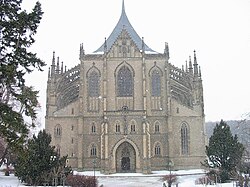Kutná Hora
| Statistics | |
|---|---|
| Area: | 33 km² |
| Population: | 21,280 (2003) |
| Map | |
| Map of the Czech Republic highlighting Kutna Hora | |
Kutná Hora ⓘ (German: Kuttenberg, medieval Czech: Hory Kutné) is a city in the Czech Republic, in Central Bohemian Region of Bohemia.
History
The town of Kutná Hora owes its origin to the silver mines, the existence of which can be traced back to the first part of the 13th century. The city developed with great rapidity, and at the outbreak of the Hussite Wars, early in the 15th century, was next to Prague the most important in Bohemia, having become the favourite residence of several of the Czech kings. It was here that, on January 18, 1419, Wenceslaus IV signed the famous Decree of Kutná Hora, by which the Czech nation was given three votes in the elections to the faculty of Prague University as against one for the three other "nations" (more details).

In 1420 the emperor Sigismund made the city the base for his unsuccessful attack on the Taborites; Kutná Hora was taken by Jan Žižka, and after a temporary reconciliation of the warring parties was burned by the imperial troops in 1422, to prevent its falling again into the hands of the Taborites. Žižka none the less took the place, and under Bohemian auspices it awoke to a new period of prosperity. In 1541 the richest mine was hopelessly flooded; in the insurrection of Bohemia against Ferdinand I the city lost all its privileges; repeated visitations of the plague and the horrors of the Thirty Years' War completed its ruin. Half-hearted attempts after the peace to repair the ruined mines failed; the town became impoverished, and in 1770 was devastated by fire. The mines were abandoned at the end of the 18th century.
Architecture


Amongst its most important buildings are the Gothic five-naved Church of St. Barbara, begun in 1368, and the Cathedral of Our Lady at Sedlec, both of which are World Heritage Sites. The Italian Court, formerly a royal residence and mint, was built at the end of the 13th century, and the Gothic Stone Haus, which since 1902 has served as a museum, contains one of the richest archives in the country. The city's suburbs include the Sedlec Ossuary.
Kutná Hora today
Since 1995 the city center has been a UNESCO World Heritage Site.
This section needs expansion. You can help by adding to it. |
External links
- www.kutnahora.info - Website of the region
- Kutna Hora - virtual tours, basic facts, sights, culture
- [1] - Historical photographs of the city
